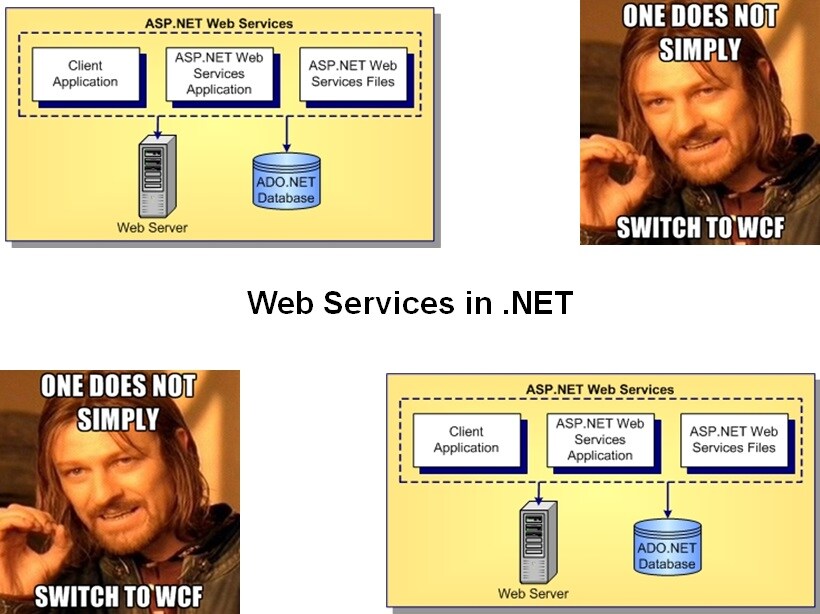- Leren door doen
- Trainers met praktijkervaring
- Klassikale trainingen
- Gedetailleerd cursusmateriaal
- Duidelijke inhoudsbeschrijving
- Maatwerk inhoud mogelijk
- Trainingen die doorgaan
- Kleine groepen
In de cursus Web Services in dotNET leren de deelnemers om Web Services met behulp van Windows Communication Foundation (WCF) en C# te ontwikkelen. De nadruk ligt op SOAP services, maar ook wordt aandacht besteed aan REST Services met de Web API.
De cursus Web Services in .NET gaat van start met een bespreking van de kenmerken WCF Web Services. Onder andere wordt daarbij ingegaan op de contracten die daarbij een rol spelen zoals WCF Contracts, Service Contracts, Data Contracts en Message Contracts.
Ook is er aandacht voor de fundamenten van het Simple Object Access Protocol (SOAP) en de Web Services Description Language (WSDL) die van essentieel belang voor zijn voor het creëren van interoperabele Web Services. Van een eenvoudige Web Service worden de SOAP berichten onderschept en wordt het WSDL geanalyseerd.
Tevens komt XML Schema, waarmee de inhoud van XML berichten qua content model en data types wordt vastgelegd, aan bod. Ook wordt de rol besproken die XML Schema heeft in de mapping tussen XML en C#.
De diverse mogelijkheden voor het hosten van WCF Web Services zoals self hosting, hosting in Windows services en hosting in IIS worden besproken.
De cursus Web Services in .NET behandelt ook de technieken voor de creatie en het debuggen van ASP.NET Web services en contracts met Visual Studio.NET en het creëren van clients van Web Services met behulp van het direct gebruik van de .NET API.
En ook de mogelijkheden van het managen van WCF service instances zoals per call services, per session services of singleton services staan op het programma.
De diverse protocollen waarover WCF Web Services kunnen werken zoals HTTP, HTTPS, TCP en UDP en hoe de configuratie daarvan in zijn werk gaat, komen eveneens aan de orde.
Tevens wordt besproken hoe WCF Web Services gebruik kunnen maken van diverse message patterns zoals one way, request-reply, callback en sessionfull.
Tenslotte komt aan de orde hoe REST Services, waarbij JSON Data worden verstuurd, worden geïmplementeerd met de Web API.
De Web Service in .NET cursus is bedoeld voor developers die .NET WCF Web Services willen begrijpen en gebruiken in hun applicaties.
Om aan deze cursus te kunnen deelnemen is kennis en ervaring met C# vereist. Kennis van ASP.NET is bevorderlijk voor een goede begripsvorming.
De cursus heeft een hands-on karakter. De theorie wordt behandeld op basis van presentatie slides. De theorie wordt afgewisseld met demo's en oefeningen. De cursustijden zijn van 9.30 tot 16.30.
De deelnemers krijgen na het goed doorlopen van de cursus een certificaat WCF Web Services in .NET.

Module 1 : WCF Intro |
Module 2 : Web Services Intro |
Module 3 : SOAP |
|
WCF versus Web Services Endpoints and Addresses WS-Addressing WCF Bindings Configuring Bindings WCF Contracts Service Contracts Data Contracts Message Contracts Fault Contracts Creating Endpoints Hosting WCF Services |
What are Web Services? Distributed Applications Evolution Role of interface RPC Example Interoperability Web Service Types Web Services Stack SOAP Web Services REST Web Services RPC Style Web Services Document Style Web Services Service Oriented Architecture |
What is SOAP? SOAP Protocol Concepts SOAP Messages SOAP Body SOAP Headers SOAP Namespaces SOAP Faults SOAP Messages as payload Message Exchange Patterns SOAP Message Path SOAP Intermediaries actor and mustUnderstand attribute |
Module 4 : XML-Schema |
Module 5 : WSDL |
Module 6 : Hosting |
| Why XML-Schema? Well formed and valid documents What XML-Schema’s? Markup Languages XML Schema Advantages XML Schema design models Classic Use of Schema’s XML Namespaces Simple and Complex types XML Schema Data Types User Defined Data Types Derivation by Restriction Derivation by Extension |
What is WSDL? Where is WSDL used? Benefits of WSDL WSDL and Code Generation WSDL in Web Service stack WSDL Namespaces WSDL Structure WSDL Elements Types and Messages PortType and Operations WSDL Bindings Service Element SOAP Messages Modes |
Hosting Types Service Description Self Hosting Service Host Creation App.config Configuration Programmatic Configuration Windows Host Managed Window Service Hosting in Windows Services IIS Hosting and .SVC File Web.config for IIS Host Windows Activation Service WAS Commands |
Module 7 : Contracts |
Module 8 : Instance Management |
Module 9 : Binding |
|
Service Contract Creating Service Contract Data Contract Service Implementation Client Side Message Pattern Message Contract Message Contract Rules Customizing SOAP MessageHeaderArray ProtectionLevel Property Name and Order Property Fault Contract |
Instance Mode Configuration Per Call Service Process of Handling Per Call Per Session Service Singleton Service Instance Deactivation ReleaseInstanceMode BeforeCall BeforeAndAfterCall Explicit Deactivation Defining Durable Services Throttling Configuration Programmatic Configuration |
Bindings and Channel Stacks Message Bubbling Basic Binding Types WS Binding Types NET Binding Types Binding Configuration Administrative Configuration Programmatic Configuration Metadata Exchange Publishing Metadata Metadata Exchange Point MEX Administrative Config MEX Programmatic Config |
Module 10 : Message Patterns |
Module 11 : Web API REST Services |
|
| Message Patterns Request-Reply One Way One Way Operation Sessionful Services Exceptions Callback Service Callback Contract Client Callback Setup Service Side Callback Invocation |
What is REST? REST Web Service Principles ID and Links REST Services with Web API Multiple Representations Embedded Path Parameters Common REST Patterns Resources URI Access JavaScript Object Notation (JSON) XML versus JSON |
